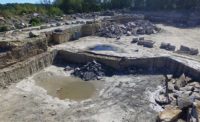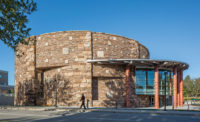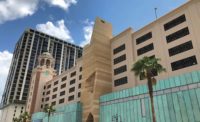Natural stone took center stage of a 10,000-square-foot residential design in Fox Chapel, PA, a suburb of Pittsburgh. A regional material was the product of choice, and a visit to the quarry sparked ideas that transpired to its extensive use for exterior applications – resulting in a stunning and sustainable design that has caught the attention of many passersby.
“The overall goal for the residence was to provide the most beautiful and important house we could build,” said architect John Cullen of Cullen & Associates, LLC in Pittsburgh, PA. “The owner was committed to stone as the exterior cladding, so we proceeded to detail the house with stone in mind.”
Cullen explained that the intention was always to use stone for the home’s design. “There was a discussion of using some real stucco above the stone, which was abandoned early on,” he said. “Stone was a more luxurious and beautiful exterior solution.”
After some consideration, Roaring Run Stone, a sandstone from Russell Stone Products’ quarry located in central Pennsylvania, was selected for the residence’s exterior facade. The homeowners gravitated towards the lighter color of the stone compared to others they had researched, said Cullen.
“The most memorable aspect of using this stone was the joy of designing the high-design aspects in 3-D,” explained the architect. “To have a product so malleable allowed our creative juices to flow. We were also inspired by visiting the quarry to understand the boundless opportunities we had in design.”
Understanding the process
Before starting the design, Cullen and his associate, Amanda Priano, visited Russell Stone Products to learn more about the material and the quarrying/fabricating operation. “Our visit to Russell Stone exposed us to the quarrying aspects of the product, helping us understand the color variations based on locations of where the stone is mined,” said Cullen. “The Russell Stone fabrication and drying facility also helped us to understand the high-quality levels the stone is produced under. The CNC machines also allowed us to see that nearly anything was possible.”
Dave Curulla of Russell Stone Products, headquartered in Grampian, PA, explained that the company’s quarry produces a sandstone in a variety of colors. “We used our Roaring Run Stone,” he said. “The beauty of the veining is unique — most of the stone is non-identical. Also, the color matched what the homeowner was trying to find.”
Curulla explained that time was taken with the homeowners and design team to educate them on the material. “Naturally, we discussed the color, the look and the feel, which are usually the first items that a customer searches for in picking a product,” he said. “Also, the ability to acquire it in the shapes and sizes they desire to be used in normal, as well as unique, situations. We pride ourselves on the ability to provide that service.”
The stone products offered by Russell Stone Products is from the Homewood sandstone family. “It has been used on projects all over the U.S., as well as overseas,” said Curulla. “It has unique veining and colors, and its durability versus other sandstones is unmatched.”
Curulla went on to say that the stone producer always promotes the sustainability of natural stone. “It has withstood freeze and thaw conditions for well over 100 years on buildings and remains viable and beautiful today,” he said. “Our stone is still in place after standing in water for over 100 years on the railroad bridges in Harrisburg, PA. The steps that Rocky ran up at the Museum of Arts in Philadelphia came from our quarry in the early 1900s. They are salted several times per day in the winter and are still in place and beautiful today.”
Communicating for success
In total, approximately 300 tons of Roaring Run Stone was supplied by Russell Stone Products for the project. This also includes the stone used for the landscaping and other outdoor structures. “We provided panels sawn on six sides, as well as rockfaced material,” said Curulla. “Some of the material was 12 x 12 inches up to 24 x 30 inches.”
Communication between all those involved played an important role in the success of the job. “Sal Staltari from Avanti Construction, the general contractor, was instrumental in keeping the dozens of sub-contractors on a schedule to make this all possible,” explained Curulla. “He kept the communication lines open and saw that the schedule was kept in a timely manner, especially with the masons and the stone deliveries.”
The architect also explained how he and his associate visited the jobsite often to maintain communication with the masonry crew. “We spent extensive time on sight overseeing the stone installation,” said the architect. “Mike, Dan and Dylan of Jubic Masonry are incredibly detail oriented. We discussed every assembly detail from the stainless steel anchors, weeps, structural limitations and every other installation detail. Working with such incredible craftsmen allowed every detail to be scrutinized to the highest level.”
Prior to the installation, Jubic Masonry, Inc. of Finleyville, PA, provided a mock-up of the sandstone for the architect and homeowners to view. “They were looking for colors of the sandstone, along with the shapes of the rockface sandstone pieces and the look of the profile that was cut into the sandstone pieces that would be used throughout the project,” said Mike Jubic, company owner. “We also provided three small mock-ups just for the choice of the color of the mortar. In my over four decades as a mason, this is the most I have worked with an architect and his associate on a project.”
On average, there were four masons on the jobsite each day. Jubic explained that after laying up the sandstone pieces at the base of the foundation — just above the finished grade – the team of masons installed flashing with a termination bar and masonry screws followed by putting silicone behind and on top of the termination bar to prevent any moister behind the flashing. “We installed weep tubes with a mortar net,” he said. “All the metal products used on this job were stainless steel made by Hohmann & Barnard Inc. They make specialty products for masonry and concrete.”
Additionally, the flashing was installed with the same details below every window sill and every window and door head. “The mortar that was used was a color mortar called ‘Colonial Tan’ made by Brixment,” said Jubic. “The sandstone pieces are all smooth-face blocks of stone below the main floor sill stones and then above the sill stones started the rockface stones except next to the windows and doors. Those sandstone pieces have a profile that was cut into the stone by Russell Stone with their CNC machine.”
The smooth and profile sandstone pieces were anchored to the concrete foundation and the house framing with special bent stainless steel anchors that were ordered specifically for this project, Jubic continued to explain. The rockface stone pieces were anchored with stainless steel wall ties along with stainless steel screws.
According to Jubic, most of the sandstone pieces were set by lifting them in place with manpower — either one or more men depending on the weight. “With the heavier pieces, we had to approach each situation separately for the installation using our all-terrain forklift,” he said. “Some of the heavy sandstone pieces we installed all-thread anchors into the stone with epoxy then using a “I bolt” into the anchor we would lift the pieces in place with lifting straps and the forklift. Some of the heavier sandstone pieces we slid in place using the forklift.
For the fireplace on the main floor, we rented a gantry to lift the stones into place.”
From design through completion, the residential project carried on for approximately three years. “The home has turned into the talk of Fox Chapel,” said Cullen. “Located on the eighth hole of the Field Club Golf Course, it gets many viewers playing golf who appreciate its majestic design and beautiful combination of sandstone, slate, wood and glass. It is truly one of the finest crafted homes in the Pittsburgh region that has been done in recent years.”
|
Private Residence Fox Chapel, PAArchitect: Cullen & Associates, LLC, Pittsburgh, PA |










